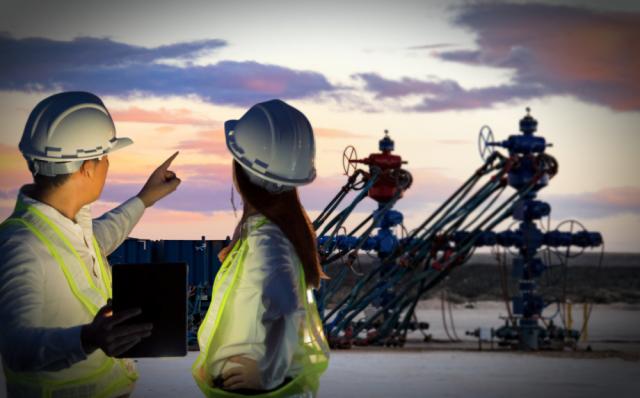
Using its digitization technology, one Intelligent Wellhead Systems client was able to conduct a well swap in the D-J Basin—a process that ordinarily would take 12 to 14 hours—in less than a minute, Standifird said. (Source: Hart Energy; Shutterstock.com)
Presented by:

This article appears in the E&P newsletter. Subscribe to the E&P newsletter here.
As more oil and gas producers begin the process of digitizing their work sites, many have seen increases in productivity and efficiency, according to Intelligent Wellhead Systems CEO William Standifird.
Whereas plans and scheduling at an oil and gas well site used to be done manually with a piece of paper on a clipboard, Standifird said digitization now connects workers all across the field and keeps everyone updated on changes, cutting downtime by a considerable amount. In addition to saving time and resources, digital completions decrease the chances of human error, ultimately improving the safety of a well site.
“I don’t think very many of us fly planes without an autopilot there, and without digital instrumentation, we would be very uncomfortable,” Standifird said. “Completions side is really no different.”
In the SPE webinar “Unconventional Well Digital Completion Technology Best Practices,” Standifird gave examples of how his company’s software is making a positive impact on well sites, as well as listed his five best practices for digital well completions, which include implementing:
- Wellsite safety practices;
- Digital lockouts;
- Sensors;
- Valve positioning; and
- Digital handshakes.
“We’re a very procedure-driven industry,” he said. “What we do is we codify processes, and historically we’ve codified those things on paper. We have clipboards, we have checklists and we have various operational procedures—the job safety analysis, for instance, management of change process.
“One of the things that’s really important for completions is migrating those processes and procedures from clipboards and paper documentation or even verbal documentation to codified software processes.”
Using this digitization technology, one Intelligent Wellhead Systems client was able to conduct a well swap, a process that ordinarily would take 12 to 14 hours, in 39 seconds in the Denver-Julesburg Basin, according to Standifird.
“If you want pump time, you want up time and you want to avoid mistakes, that’s what these types of technologies really help you do,” he said. “When you codify a procedure electronically, then the humans are not having to second-guess where they are in the procedure every time.”

“It’s sort of like using Goggle Maps or Waze to drive to a destination,” he continued. “Because [the GPS system is] guiding you, and you can see the compass, and you can see the road, and you can see the next step. It allows you to move very fast and that’s what these technologies allow you to do.”
The digitization process is not only improving efficiency but also safety on the well site by keeping all workers up-to-date on any occurring changes and risks, as well as reducing the number of mistakes that can lead to injury.
When prioritizing the two qualities of efficiency and safety, Standifird said safety will always come before efficiency, but the digital completion technology is fortunate enough to check both boxes.
“As much as we depend on humans every day for their innovation, for their dedication to the work, at the end of the day, humans are typically responsible for making mistakes that result in lost time and injury, so the computers and digitalization can really help us move completions forward faster and more safely,” he said.
Ultimately, the digital completions process ties together an entire team of people and ensures that they are all on the same page throughout each stage of the completions process.
“I understand how difficult it is to have operations with thousands of people where you’re trying to instrument a process to prevent bad things from happening,” Standifird said. “Humans ultimately are not as good at consistently applying processes as computers are, so by codifying certain things and taking that decision making away from the human or augmenting the human’s decision-making, you just end up with a lot better results.”
Recommended Reading
Range Resources Holds Production Steady in 1Q 2024
2024-04-24 - NGLs are providing a boost for Range Resources as the company waits for natural gas demand to rebound.
Hess Midstream Increases Class A Distribution
2024-04-24 - Hess Midstream has increased its quarterly distribution per Class A share by approximately 45% since the first quarter of 2021.
Baker Hughes Awarded Saudi Pipeline Technology Contract
2024-04-23 - Baker Hughes will supply centrifugal compressors for Saudi Arabia’s new pipeline system, which aims to increase gas distribution across the kingdom and reduce carbon emissions
PrairieSky Adds $6.4MM in Mannville Royalty Interests, Reduces Debt
2024-04-23 - PrairieSky Royalty said the acquisition was funded with excess earnings from the CA$83 million (US$60.75 million) generated from operations.
Equitrans Midstream Announces Quarterly Dividends
2024-04-23 - Equitrans' dividends will be paid on May 15 to all applicable ETRN shareholders of record at the close of business on May 7.





